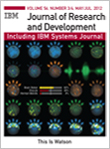| |||||||

|
|
||||||
This is Watson
In 2007, IBM Research took on the grand challenge of building a computer system that could compete with champions at the game of Jeopardy!. In 2011, the open-domain question-answering system dubbed Watson beat the two highest ranked players in a nationally televised two-game Jeopardy! match. This special issue provides a deep technical overview of the ideas and accomplishments that positioned our team to take on the Jeopardy! challenge, build Watson, and ultimately triumph. It describes the nature of the question-answering challenge represented by Jeopardy! and details our technical approach. The papers herein describe and provide experimental results for many of the algorithmic techniques developed as part of the Watson system, covering areas including computational linguistics, information retrieval, knowledge representation and reasoning, and machine leaning. The papers offer component-level evaluations as well as their end-to-end contribution to Watson.s overall question-answering performance.
In 2007, IBM Research took on the grand challenge of building a computer system that could compete with champions at the game of Jeopardy!. In 2011, the open-domain question-answering system dubbed Watson beat the two highest ranked players in a nationally televised two-game Jeopardy! match. This special issue provides a deep technical overview of the ideas and accomplishments that positioned our team to take on the Jeopardy! challenge, build Watson, and ultimately triumph. It describes the nature of the question-answering challenge represented by Jeopardy! and details our technical approach. The papers herein describe and provide experimental results for many of the algorithmic techniques developed as part of the Watson system, covering areas including computational linguistics, information retrieval, knowledge representation and reasoning, and machine leaning. The papers offer component-level evaluations as well as their end-to-end contribution to Watson.s overall question-answering performance.
19 Results returned








